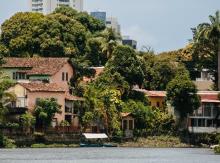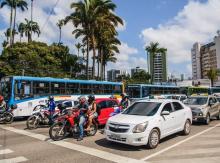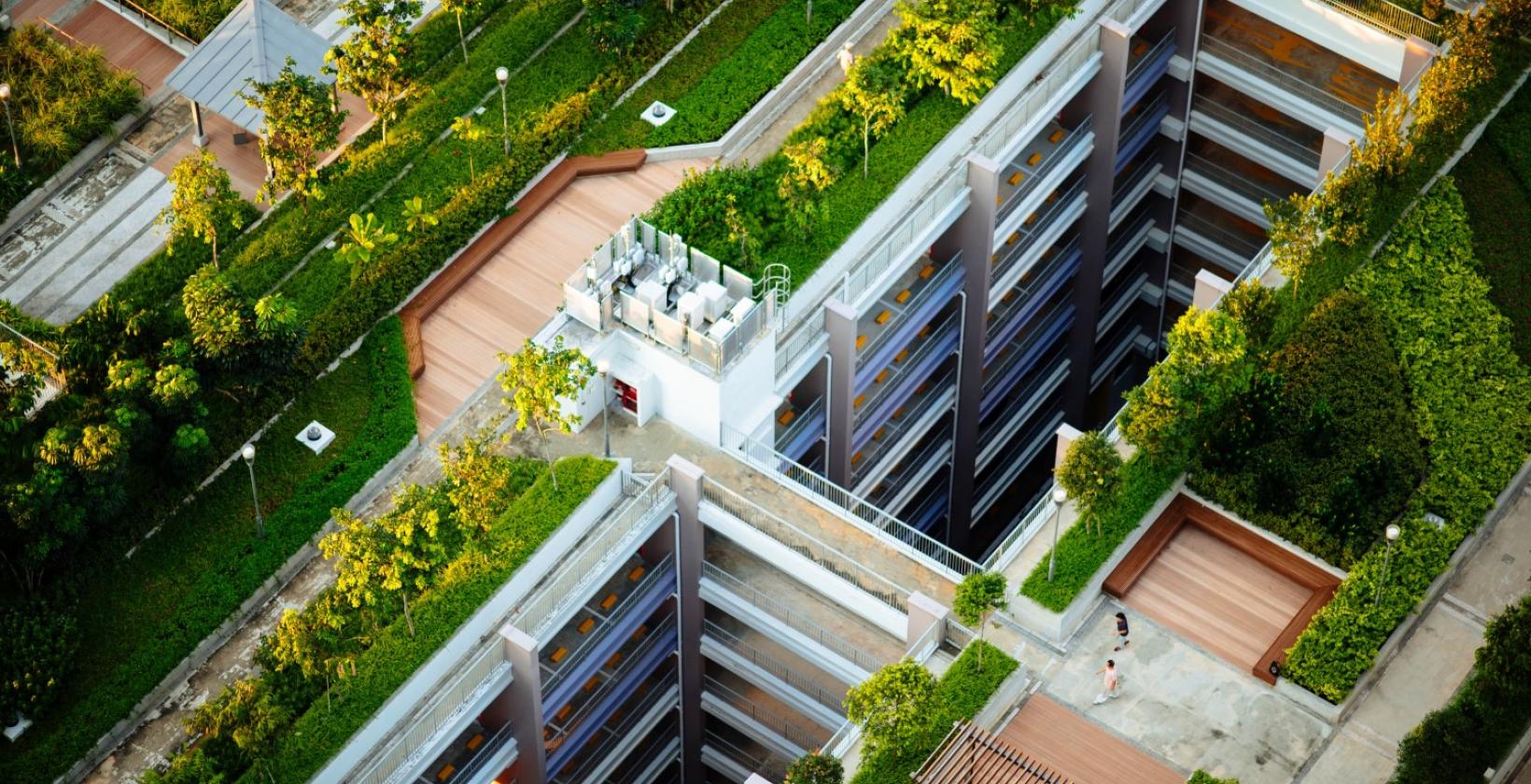City Spotlight
Resilient Infrastructure in Brazil's Cities Grows from the Roots
How cities from Recife to Belém are pursuing innovative green strategies with the support of the Global Environment Facility.
On the river in Recife (Photo credit: UNEP/Aidan Dockery)
Innovative city infrastructure can look like concrete and iron — or like mangroves. The Brazilian city of Recife, built across three islands, has embraced nature as an ally in urban planning and public space design. Rather than resisting the natural environment, the city is now designing solutions around it.
Recife lies on a floodplain at the junction of the Beberibe and Capibaribe rivers before they drain into the Atlantic Ocean. For decades, the city has struggled with flooding, lack of sufficient public spaces, deficient sewage systems, and poor water quality. People living along the riverbanks have regularly faced devastating impacts from heavy rains and rising waters, affecting their homes, mobility, and livelihoods.
However, a new filtering garden in a public park is paving the way for this to change. This nature-based infrastructure solution was designed to demonstrate how the natural world can support us to address urban challenges, in this case water quality.
The filtering garden, which also led to the rejuvenation of the public park, means that residents in the neighborhood now have access to higher-quality and safer public spaces. “As we had hoped, this has become an extension of our homes,” said Fabiane de Lima, who lives along the river. “It is a leisure area we don’t often have at home because many don’t have a backyard or balcony.”

This innovation didn’t stand alone. A series of complementary interventions in the area helped reduce waste and emissions, improve water quality, and make access to public services easier through sustainable mobility options such as pedestrian bridges and walkable river paths. Parks by the riverbank are now also safer for women and children, who in the past used to avoid the area.
These benefits reflect the power of integrated planning. "Tackling climate change, nature, and pollution challenges all at once is no longer a chimera. In fact, it is especially crucial in cities, where every intervention must address these multiple issues and also enhance the livelihoods of the many people that live in these urban spaces,” said Asher Lessels, Head of UNEP’s GEF Climate Mitigation Unit.
Brazil is implementing several such holistic interventions with support from the GEF and UNEP, in support of sustainable urban development. Two such projects, led by the Brazilian Ministry of Science, Technology and Innovation, are called CITinova I and II. These support Brazil with $35 million in GEF grants and $380 million of mobilized co-finance. These initiatives involve collaboration across federal, metropolitan and local government departments as well as support for the development of climate and nature local policies, with the further aim of informing national policy.

In the Amazonian city of Belém and its surrounding metropolitan region, rapid urbanization driven by mining, agriculture, and services is placing immense pressure on the surrounding ecosystems and infrastructure. Cities like Ananindeua and Marituba have become residential and industrial extensions of Belém, intensifying commuter flows and environmental stress. These dynamics transcend municipal boundaries, making coordinated governance crucial for effective climate action.
To address these challenges, a GEF-funded initiative supported by UNEP and implemented by the Brazilian Ministry of Science, Technology and Innovation is piloting a low-emission street in Belém’s city center, targeting emissions from transport, buildings, and waste, while also establishing a mosaic of protected areas that integrate conservation across jurisdictions. This metropolitan-scale effort is helping enhance the area’s resilience to flooding, heat stress, and biodiversity loss.
The project also supports sustainable livelihoods through urban bioeconomy strategies, such as strengthening agroforestry on Combú Island and supporting local businesses like ice cream shops and chocolate makers. These interventions ensure that economic benefits remain within communities while promoting nature-based, circular, low-carbon practices.
“Urbanization challenges are not contained within cities. By expanding the focus from the municipal to the metropolitan scope and surrounding ecosystems, the initiative brings national, state, and local governments together, creating replicable models for inclusive, nature-positive, and low-emission urban planning,” said Mohamed Bakarr, GEF Manager of Integration and Knowledge. “This integrated approach is not just about protecting the environment – it’s about transforming urban governance and planning systems for building healthier, more resilient, and equitable cities for the future.”

The positive social and economic impact of these solutions is also inspiring new initiatives. For instance, the success of Recife’s pilot project has sparked interest in creating new riverfront facilities such as piers and public spaces, plus investments in sustainable mobility across the river, building on the same inclusive approach.
"The main goal is that the knowledge and lessons learned from these programs continue to have an impact on communities across the country by scaling them up and adapting them to many more municipalities across Brazil,” said Osvaldo Luiz Leal de Moraes, Deputy Secretary for Policies and Strategic Programs and Director of the Department of Climate and Sustainability at Brazil’s Ministry of Science, Technology and Innovation.
“Brazil has committed to cutting its emissions between 59 percent and 67 percent by 2035. And municipalities play an extremely important role in achieving that goal. In fact, Brazil’s new National Mitigation Plan outlines how emission reductions in cities are a must for Brazil to meet its NDC targets, and special attention needs to be paid to the energy transition.”
The urgency is clear, globally where two-thirds of the world’s population will live in cities by 2050 and in Brazil which will host the 30th UN Framework Convention on Climate Change Conference of the Parties (COP30) in November.
“We can’t discuss the environment without looking at cities,” said Jader Filho, Brazil’s Minister of Cities. As the COP30 host, Brazil recognizes that investing in sustainable urban infrastructure today will save money, lives, and livelihoods—now and in the future.
These projects in Brazil are part of the GEF-funded Sustainable Cities Program. Currently in its third phase, the program directly supports over 90 cities across 33 countries, focusing on integrated urban planning and innovative sustainability solutions. It has contributed to the development of global knowledge and partnership platforms UrbanShift and Global Platform for Sustainable Cities, which facilitate collaboration among cities and stakeholders. These initiatives aim to transform urban systems for the benefit of people and the planet through sustainable, integrated, nature-positive, and net-zero urban development.

How an Urban Bioeconomy can Promote Healthy Ecosystems and Spur Sustainable Economic Prosperity
In Belém, Brazil and other Latin American cities, this concept—which emphasizes circularity, renewable resources, and the development of green infrastructure—is already taking root and reshaping local economies.

Building connections to support sustainability across the world's cities
How UrbanShift is supporting the goals of a range of global initiatives for climate action and sustainability.

UrbanShift Annual Report Launch Webinar: Reflecting on 5 Years of Impact
This webinar will highlight voices from around the UrbanShift network and spotlight stories of sustainable urban transformation.

How Teresina is Accelerating its Transition to a Green and Resilient City
From UrbanShift's capacity-building activities, this scorching city in northeastern Brazil is drawing inspiration and technical knowledge to build sustainability from the ground up.

